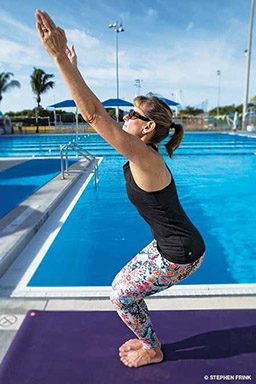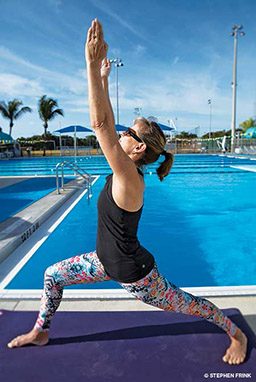Divers strive to safely optimize air consumption to allow for the possibility of more bottom time. Practicing rhythmic breathing without breath holding can benefit divers — or anyone. Yoga is an excellent way to refine and maintain your ability to breathe rhythmically even during periods of physical exertion.
Yoga and scuba diving share a similar peaceful energy and emphasis on proper breathing to maximize the quality of the experience. Ujjayi (oo-jie-yee), also known as victorious breath, is a breathing technique used in many yoga practices. Ujjayi is performed by constricting the back of the throat slightly as you breathe in and out through the nose with inhalations and exhalations of equal length. The breath constriction creates a sound like that of ocean waves or Darth Vader. Using the ujjayi breath during yoga gives the practitioner a basis for monitoring the physical demand on the body. If the breath becomes strained the practitioner can decrease the intensity to maintain smooth, steady and equal breaths. (This breathing technique should not be used while diving.)
Here are five basic yoga poses to try while using the ujjayi breath. Start and end with mountain pose. To increase intensity you can add chair pose in between each pose. All poses begin from standing.
Mountain

- Stand with your feet hip distance apart (or with feet together and big toes touching).
- Contract your thigh muscles to pull up the knee caps.
- Descend the tailbone (i.e., subtly rotate the pelvis to point the tailbone toward the ground, lowering it slightly), draw the navel to the spine, and relax the shoulders down the back, away from the ears.
- Gaze forward. Distribute your weight equally between the balls and heels of both feet.
- Stay here for 10 cycles of ujjayi breaths.
Chair

- Bend your knees as if to sit in a chair. Keep the knees over the ankles and not forward of the toes. The legs can be touching or hip distance apart.
- Descend the tailbone to release arch in the back, and bring your arms over your head in line with your ears.
- Gaze forward or up at your separated hands.
- Root into the feet (i.e., balance your body weight between the balls and heels of both feet).
- Stay here for five breath cycles.
Warrior I

- Take a big step back with your left foot. The foot should be turned out slightly and pressed firmly into the ground.
- Bend your right knee 90 degrees to bring the thigh parallel to the mat, and keep the knee over the ankle. Engage the quadriceps of the left leg, and press into the right foot.
- Sweep your arms overhead, shoulder distance apart, relaxing the shoulders down the back, away from the ears.
- Gaze at the thumbs or forward.
- Stay here for five breath cycles. Repeat on other side.
Warrior II

- Take a big step back with your left foot, placing it perpendicular to the right foot. The instep of the left foot should be in line with the heel of the right foot.
- Bend the right knee 90 degrees, bringing the thigh parallel to the mat and keeping the knee over the ankle. Engage the quadriceps of the left leg, and press into the right foot and the outer edge of the left foot.
- Extend the arms parallel to the ground (right arm forward and left arm back) in line with the ankles. Reach through the fingertips of each hand, and relax the shoulders down the back, away from the ears.
- Gaze over the middle finger of the right hand.
- Stay here for five breath cycles. Repeat on other side.
Extended Side Angle

- Take a big step back with your left foot, placing it perpendicular to the right foot.
- Bend the right knee 90 degrees, taking care to keep the knee above the ankle and not forward of the toes.
- Press into the outer edge of the left foot, lifting the left arch. Engage the quadriceps of left leg, and press into the right foot.
- Place the right forearm on the right thigh, and extend the left arm over the head. Rotate the chest toward the sky.
- Stay here for five breath cycles. Repeat on the other side.
A consistent yoga practice can improve strength and flexibility and can yield a healthier mind and body. To embrace the full benefits of a yoga practice, find a yoga studio or registered yoga teacher (RYT). Always consult your physician before beginning any exercise program or changing your physical activity patterns.
DAN Note
To avoid an increased risk of decompression sickness, DAN recommends that divers avoid strenuous exercise for 24 hours after making a dive. During your annual physical exam or following any changes in your health status, consult your physician to ensure you have medical clearance to dive.
© Alert Diver — Q2 Spring 2015